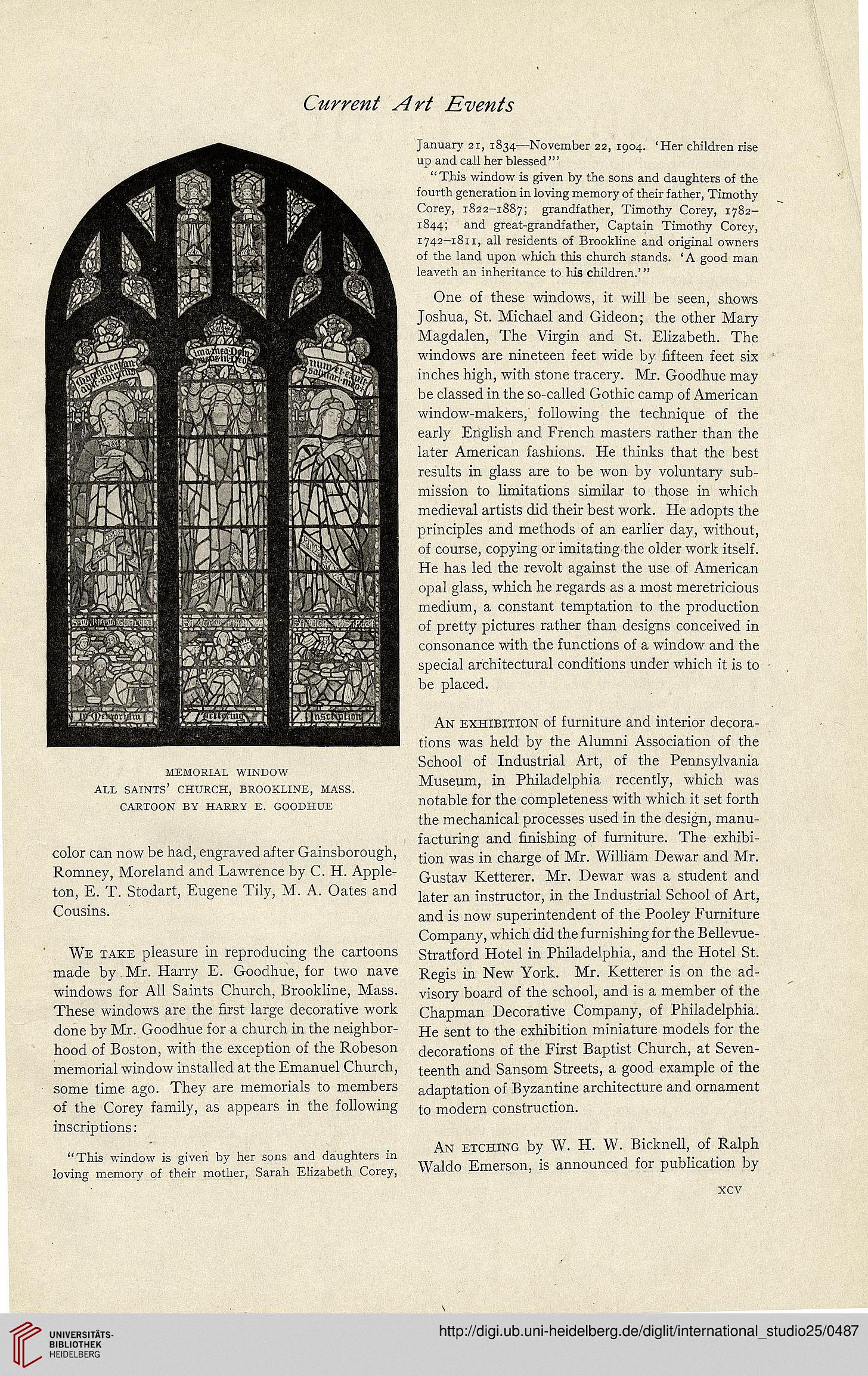MEMORIAL WINDOW
ALL SAINTS' CHURCH, BROOKLINE, MASS.
CARTOON BY HARRY E. GOODHUE
color can now be had, engraved after Gainsborough,
Romney, Moreland and Lawrence by C. H. Apple-
ton, E. T. Stodart, Eugene Tily, M. A. Oates and
Cousins.
WE TAKE pleasure in reproducing the cartoons
made by Mr. Harry E. Goodhue, for two nave
windows for All Saints Church, Brookline, Mass.
These windows are the first large decorative work
done by Mr. Goodhue for a church in the neighbor-
hood of Boston, with the exception of the Robeson
memorial window installed at the Emanuel Church,
some time ago. They are memorials to members
of the Corey family, as appears in the following
inscriptions:
"This window is given by her sons and daughters in
loving memory of their mother, Sarah Elizabeth Corey,
January 21, 1834—November 22, 1904. 'Her children rise
up and call her blessed'"
"This window is given by the sons and daughters of the
fourth generation in loving memory of their father, Timothy
Corey, 1822-1887; grandfather, Timothy Corey, 1782-
1844; and great-grandfather, Captain Timothy Corey,
1742-1811, all residents of Brookline and original owners
of the land upon which this church stands. 'A good man
leaveth an inheritance to his children.'"
One of these windows, it will be seen, shows
Joshua, St. Michael and Gideon; the other Mary
Magdalen, The Virgin and St. Elizabeth. The
windows are nineteen feet wide by fifteen feet six
inches high, with stone tracery. Mr. Goodhue may
be classed in the so-called Gothic camp of American
window-makers, following the technique of the
early English and French masters rather than the
later American fashions. He thinks that the best
results in glass are to be won by voluntary sub-
mission to limitations similar to those in which
medieval artists did their best work. He adopts the
principles and methods of an earlier day, without,
of course, copying or imitating the older work itself.
He has led the revolt against the use of American
opal glass, which he regards as a most meretricious
medium, a constant temptation to the production
of pretty pictures rather than designs conceived in
consonance with the functions of a window and the
special architectural conditions under which it is to
be placed.
AN EXHIBITION of furniture and interior decora-
tions was held by the Alumni Association of the
School of Industrial Art, of the Pennsylvania
Museum, in Philadelphia recently, which was
notable for the completeness with which it set forth
the mechanical processes used in the design, manu-
facturing and finishing of furniture. The exhibi-
tion was in charge of Mr. William Dewar and Mr.
Gustav Ketterer. Mr. Dewar was a student and
later an instructor, in the Industrial School of Art,
and is now superintendent of the Pooley Furniture
Company, which did the furnishing for the Bellevue-
Stratford Hotel in Philadelphia, and the Hotel St.
Regis in New York. Mr. Ketterer is on the ad-
visory board of the school, and is a member of the
Chapman Decorative Company, of Philadelphia.
He sent to the exhibition miniature models for the
decorations of the First Baptist Church, at Seven-
teenth and Sansom Streets, a good example of the
adaptation of Byzantine architecture and ornament
to modern construction.
AN ETCHING by W. H. W. Bicknell, of Ralph
Waldo Emerson, is announced for publication by
xcv




